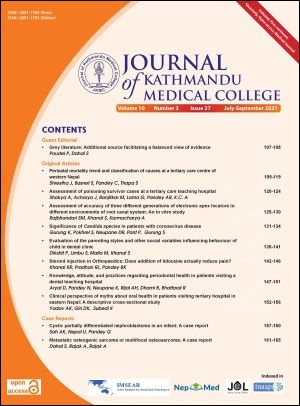Assessment of poisoning survivor cases at a tertiary care teaching hospital
DOI:
https://doi.org/10.3126/jkmc.v10i3.41207Keywords:
Agrochemical, Poisoning, SuicideAbstract
Background: Poisoning is one of the most common causes of increased morbidity and mortality worldwide and also one of the common causes of Emergency Department visits. It has now become a major public health issue.
Objectives: To assess the poisoning survivor cases and various associated parameters like most common poison, the circumstance of poisoning, age and gender distribution, and triggering factors.
Methods: A retrospective study was done in 94 cases of poisoning, from whom reliable history could be obtained, admitted to Kathmandu Medical College, over the period of 12 months, from April 2019 to March 2020. After obtaining ethical clearance secondary data were collected from the medicolegal examination reports. The data were entered and analysed in Statistical Package for Social Sciences (SPSS) v.18.
Results: Majority of the victims were females (9, 62.8%), mostly homemakers (31, 33%). The mean age of the population was 30.35 ± 13.48 years and median age 26 years. Organophosphorus was the most frequent agent (44, 46.8%). The commonest triggering factor was a quarrel with family members (56, 65.1%) and in most cases the agent was already present in their home. The act of poisoning was impulsive in these cases.
Conclusion: In this study, the most common agent causing poisoning was still organophosphorus which was already present in their homes. Most poisoning cases were intentional. Females especially homemakers were the most common victims. Cases of poisoning can be reduced if the authorities properly monitor the buying and selling of these common agents of poisoning.
Downloads
Downloads
Published
How to Cite
Issue
Section
License
Copyright © Journal of Kathmandu Medical College
The ideas and opinions expressed by authors or articles summarized, quoted, or published in full text in this journal represent only the opinions of the authors and do not necessarily reflect the official policy of Journal of Kathmandu Medical College or the institute with which the author(s) is/are affiliated, unless so specified.
Authors convey all copyright ownership, including any and all rights incidental thereto, exclusively to JKMC, in the event that such work is published by JKMC. JKMC shall own the work, including 1) copyright; 2) the right to grant permission to republish the article in whole or in part, with or without fee; 3) the right to produce preprints or reprints and translate into languages other than English for sale or free distribution; and 4) the right to republish the work in a collection of articles in any other mechanical or electronic format.




